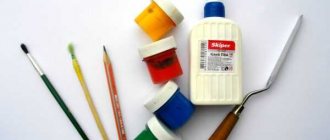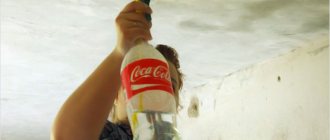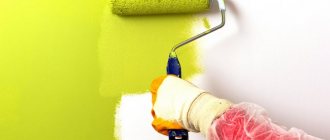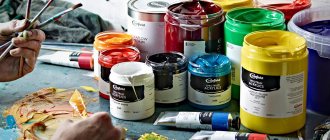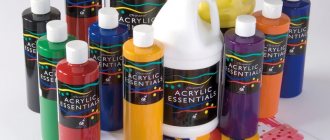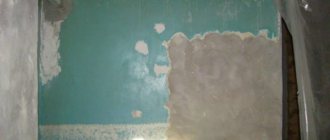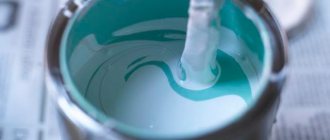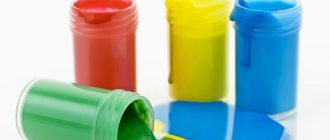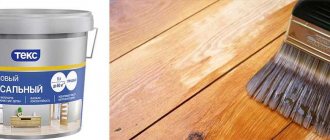Painting surfaces in the construction industry has been known since time immemorial. In the middle of the last century, this type of finishing was dominant. However, with the advent of new finishing materials, paint began to lose its position. A surge of interest in painting building elements recently is associated with the emergence of a line of water-soluble paints, which are significantly superior to their predecessors based on organic solvents.
On retail shelves today you can find hundreds of types of water-based paints, with different compositions of components and, therefore, different consumer properties. Professionals, not to mention ordinary buyers, cannot always understand this diversity. To simplify the choice, marketing workers came up with an interesting move: they divided the paints into latex and acrylic. As a result, the search comes down to deciding the question: what to choose - acrylic or latex paint.
Note that the approach is original, since there are no latex paints as such in nature. After all, latex is the sap of the tropical Hevea tree or the familiar dandelion, which, no matter how hard they try, do not have enough “milk” to produce even 1% of paints. So why are paints called latex?
Types of polymer binders
Among chemists, the term “latex” has two meanings. One is Hevea juice or its synthetic substitute made from isoprene, urethane, styrene butadiene, acrylic, etc. polymer. The second, derived from English. latex is a dispersed emulsion of polymer particles in water. Acrylic paint is nothing more than an emulsion of dispersed particles of acrylic or its derivatives: acrylates (polymers) dissolved in water, i.e. This is pure latex paint, if you adhere to the official terminology.
To avoid confusion in the future, let us clarify what is meant when a comparison is made as to which paint is better, latex or acrylic. Modern water-soluble paints may contain acrylic copolymers (acrylates) or styrene-butadiene copolymers as binders. A class of paints based on a dispersion of acrylates dissolved in water is called “acrylic paint”. And dyes with butadiene-styrene copolymers began to be called “latex paint.”
A different name for a water-based emulsion does not change the essentially identical composition of the components of the coloring matter, which includes:
- binders - substances responsible for adhesion, resistance to mechanical stress, service life of the applied paint layer and other characteristics, both physical and operational. They can be polymers or copolymers (the composition contains several types of polymers, including both acrylates and styrene-butadiene polymers);
- solvent - in water-emulsion dispersions it is water;
- pigments or colors - fine powder or liquid that colors the composition in any color or tone (more than 200 varieties);
A rare correct description.
- stabilizers - additives that improve the quality characteristics of paint or determine the scope of its application (for external or internal work, application to metal, wood, glass, etc.);
- fillers - substances responsible for the level of gloss of the surface of the applied paint layer (matte, semi-matte, glossy, etc.).
Material consumption
Many users are interested in the consumption of latex acrylic paints. Depending on the coating application method, the amount of coloring material may vary. Experienced craftsmen prefer to use rollers. Coloring is done by repeatedly rolling over the surface. Depending on the porosity of the wall or ceiling, using a roller consumes up to 250...350 g/m² of paint.
If a brush is used in the work, then the consumption increases by 20...25%. When air-drop painting (using a spray gun), 10...15% more dye is consumed than when painting with a roller.
Attention! For a spray gun, paints are diluted with water to reduce the viscosity of the material.
Advantages and disadvantages
Water-based paints have their strengths and weaknesses. But since we are talking about comparing paints within the same type, it is not advisable to dwell on this. Therefore, we will consider the pros and cons of acrylic and latex paint separately.
Latex paint
A water-based emulsion based on styrene-butadiene polymers has quite a few advantages:
- long service life. However, with a caveat, since in places exposed to sunlight it quickly fades, and therefore durability can only be discussed in rooms without ultraviolet rays: corridor, hallway, storage room;
- high level of wear resistance, which makes it possible to paint not only the ceiling, but also the walls;
- lower price among all types of water-based paint;
- increased moisture resistance, which allows for wet cleaning. However, this does not mean that such paint can be washed frequently and used to paint the ceiling and walls in the bathroom;
- good elasticity - a layer of paint hides minor defects in the surface of the walls (ceiling) well. The same property works well when painting wallpaper;
- more attractive appearance of the painted surface - silkiness appears;
- absence of a wet smell during application, which is observed with acrylic analogues;
- good adhesion to all types of wall materials, including porous ones.
Flaws:
- fades under UV rays;
- is afraid of sudden temperature changes, and therefore cannot be used as façade paint;
- serves as a good nutritional base for the growth of fungus and mold, which requires mandatory priming of the surface before painting with the addition of antiseptic materials.
Attention: latex paints have recently appeared on sale for facade work, where the main binder, styrene-butadiene, is scarce.
Acrylic paints
Acrylic paints have typical strengths and weaknesses for latex paints. Pros:
- durability;
- excellent adhesion to all types of building materials;
- elasticity;
- UV resistance;
- the widest range of colors (up to 5 thousand);
- does not become covered with a network of wrinkles during temperature fluctuations;
- tolerates frosts down to -40oC (with the addition of special fillers, the indicator drops to -60oC) - the facade can be painted;
- resistance against fungus;
- high level of vapor permeability - the walls “breathe” under the paint.
The disadvantages include:
- quite high price;
- presence of odor (disappears immediately after the walls dry).
How to apply latex composition correctly
This variety is no different from its analogues in terms of the method of application - you can dilute it a little before applying it on top of the primer.
Experts recommend applying 2 layers. The disadvantages of latex emulsions include the need to pre-treat the wall with a primer.
To more accurately calculate the required volume, it is important to compare the covering power and the area of the treated surface. The second layer may be a little thinner if the quality of the previous one is quite satisfactory
Elastic polymers “stretch” well over surfaces. Twice application is enough to ensure the aesthetics and durability of rich color.
On the modern market, colors are presented in a wide range of colors, which allows you to purchase any shade.
Surface treatment sequence:
- Remove dirt and old paint layers.
- Fix minor defects with gypsum putty, re-plaster with finishing mixture (if necessary) after drying.
- Vacuum thoroughly to remove all abrasive particles.
- Treat with an antifungal compound and primer for latex compounds.
- After drying, cover with masking tape all parts that do not require painting.
- Prepare the paint; if it is too thick, dilute it a little with water (the proportion should be indicated on the can, usually 5:1) and pour it into the tray for painting with a painting tool.
- Start painting with a narrow brush in hard-to-reach places, then work with a wide brush or brush with medium pressure for even distribution.
- After complete drying, reapply the paint.
Latex paint is widely used to decorate living rooms, bedrooms and children's rooms.
To paint ceilings and negative surfaces (tilted towards you, as in an attic), you need a thick composition. It is difficult to distribute without experience. It is recommended to contact a ceiling painting specialist. It is not recommended to use a roller with thick latex - the quality of emulsion distribution decreases.
It is better to give preference to an option with a lower degree of gloss. Semi-matte paint is the best option.
Performance Comparison
To compare the main characteristics of acrylic and latex paints, we will use the following criteria:
- paint cost;
- durability;
- wear resistance;
- hiding power;
- consumption per 1 m2;
- versatility;
- moisture resistance;
- resistance to fading.
Which is cheaper?
The price indicator of the finishing material often plays a decisive role when carrying out repair work, often to the detriment of other characteristics. In general, latex paints based on styrene-butadiene copolymers are 15-65% cheaper than acrylic paint compositions.
There is no point in talking about specific prices, since extraneous factors are mixed in here: brand awareness, quantity and type of stabilizers, type of fillers (prices for the same paint with a matte and glossy surface are different), etc. For example, for paint with the same chemical composition the price can vary from 300 rubles/l to 3,000 rubles/l.
Recently, it has become a trend to mix these types of paint when renovating apartments to reduce the burden on the financial component.
Durability
Service life is determined by several factors: wear resistance, ability to withstand ultraviolet rays and withstand high humidity. If we take into account ideal operating conditions, then both types of paint have the same performance - about 20 years. In reality, acrylic paints have a higher durability, since for latex compositions the sun sometimes appears, and high humidity occurs, etc.
Wear resistance
All types of paints have 5 wear resistance classes. The paints being compared can be grades 1-3. According to this indicator, they are completely equal.
The wear resistance class is determined as follows:
- a layer of paint 250 microns thick is applied to the surface to be painted;
- the surface is dried;
- after drying, the thickness of the dried layer is measured;
- with a special sponge with a given force, the machine runs over the paint in both directions 200 times;
- The thickness of the remaining paint layer is measured.
The larger it is, the higher the abrasion class (the highest is class 1).
Covering power
Non-professionals often confuse two similar indicators: hiding power and paint consumption per 1 m2. If we explain the essence of hiding power in understandable language, then it is the transparency of the layer of applied paint or its ability to completely cover the original color of the surface being painted.
The indicator is designated by a class from 1 to 5 and depends on the ratio between binders and pigment, binders and filler, the size of the pigment and filler particles, as well as the number of dye particles. The higher the hiding power, the lower the paint consumption. This means you can buy a more expensive paint with a high opacity rating and save money by using fewer coats.
Sequence of the hiding power test.
Acrylic and latex paints generally have coverage class 2, although well-known European brands also have class 1 (this allows you to almost always get by with 1 layer of paint, despite the bright spots on the surface being painted).
Consumption
When painting a surface, the thickness of the paint layer may vary. It all depends on its elasticity. The higher it is, the less paint consumption per 1 m2. For acrylic paint, this indicator varies in the range of 0.20-0.25 kg/m2, for latex paint - 0.15-0.20 kg/m2 - it has higher elasticity.
Important: in the tables that can be found on the Internet, the consumption of latex-based paint is indicated at 0.6 kg/m2, which is not true. You can verify this by looking at the consumption on paint cans on sale. Basically this is 18-24 m2 for a can weighing 3 kg. Another topic: what is the point of buying latex paint with a consumption almost 3 times higher than that of acrylic paint with a price less than 15-25%.
Versatility
According to the criterion of versatility, acrylic paint has an overwhelming advantage: it can be used without restrictions on the types of materials and place of application, including outside buildings. Latex paint cannot be used to paint facades and wet rooms.
Moisture resistance
Paints have different levels of moisture resistance. Latex can be cleaned with a wet rag or sponge, acrylic &mdsah; paint rooms with high humidity.
Resistant to fading
Latex paint is afraid of ultraviolet rays - it quickly fades under them. Acrylic can be used under daily sun for 10 years without losing the original color tone.
Review of manufacturers
Among domestic manufacturers, the products of the Lakra brand are popular. The company has been producing paint and varnish products for 20 years. Using many years of experience and applying the latest developments in the field of manufacturing paints and enamels, the company has launched the production of high-quality products, which in their properties and technical characteristics are in no way inferior to famous foreign analogues.
Russian products are no less famous. It is widely available and has many positive reviews. The company produces a full range of paint and varnish products, offering high quality at affordable prices.
What and in what case is it better to choose
Based on the strengths and weaknesses of the paints being compared, as well as the result of contrasting their main characteristics, we can give some advice on what is best to choose and in what case.
Acrylic. The paint is a universal type. Therefore, it can be used without restrictions both indoors and outdoors. In the presence of special stabilizers, it can be used for painting walls and ceilings in damp rooms, such as the kitchen and bathroom. You can find out about the level of water resistance on the packaging.
Latex. Paint based on the styrene-butadiene group is not a universal type of dye. Therefore, its use is limited to the interior of an apartment or house. In addition, there are restrictions on rooms with high humidity and sudden temperature changes. For example, windows in rooms should not be opened wide in winter, as the paint layer may crack and fall off.
At the same time, such characteristics of paint as lower price, ability to set faster and better appearance give it advantages when choosing paint for walls, especially for the north side of the apartment (paint on the south side fades in the sun).
For the corridor, hallway and closet it is also better to choose latex paint. In terms of its consumer characteristics, it is in no way inferior to acrylic paint, but it costs less.
If you want to save money, you can mix latex and acrylic paints in approximately equal proportions and paint the entire apartment, with the exception of the bathroom and the “apron” with the ceiling in the kitchen. However, it should be remembered that neither pure latex nor a mixture with acrylic paint is categorically suitable for outdoor work and unheated premises (dacha).
Varieties
The following types of acrylic paints are produced:
- Glossy . Dries quickly and dissolves using ordinary tap water.
- Glypthal . They contain acrylic resin and are the most common. They form a special waterproof film and are used for painting residential premises.
- Special . They are produced completely ready for use and do not require the use of a primer even before painting the metal, since they have anti-corrosion properties.
Therefore, no matter what kind of painting work you plan to carry out, choosing an acrylic composition will not be any problem.
Can paints be mixed with each other?
In the process of carrying out renovation work, owners often want to mix two types of paints with each other. This may be a desire to change the appearance of the surface being painted (a layer of latex paint appears silky) or simply to save the family budget (the difference in price is significant).
Internet searches do not provide a concrete answer. It all comes down to the phrase “experts do not advise conducting such experiments.” Let's try to figure it out in more detail.
1. Technologically, there are no obstacles to mixing paints:
- the solvent is the same - water;
- binder polymers are in the form of dispersions;
- There are practically no coloring compositions with one type of polymer - there is always the presence, albeit in small quantities, of other representatives of the polymer group, or, as chemists say, copolymers.
2. Finally, the main argument: on sale you can find paints with acrylates and styrene-butadiene polymers in one “bottle” - manufacturers thus reduce the cost of their products.
3. Paints have different attitudes to sunlight and temperature changes. Therefore, such a mixture is not suitable for painting external surfaces - no one knows how it will behave during operation. But for interior work there are no obstacles to mixing.
Conclusion: the editors see no reason why two types of paint cannot be mixed when performing finishing work in heated rooms.
Differences
Despite the similarity of names, the difference between water-based and water-dispersion coatings is obvious:
- Dispersion assumes the presence of tiny particles in the base. If such particles take the form of a liquid, then we are talking about an emulsion.
- The water-dispersion coating is harder and highly resistant to damage, which cannot be said about water-based paint. The cost of water-based paints is often higher.
- Water-dispersion paint is reliable and water-resistant, while water-based paint is easy to wash off.
- Water-based paint has a wide range of different shades; water-dispersion coating comes in only one color - white.
- Water-dispersed materials must be diluted with water, emulsion materials need to be diluted with organic solvents.
Knowing the distinctive properties and advantages that both types of paints have will guarantee the correct choice of paint coating.
An important rule that should be followed when choosing and purchasing coverage is that you should give preference only to trusted manufacturers and specialized stores with a good reputation.
There are other tips for choosing paint, which you can learn from the following video.
The aesthetics, quality, and durability of the painted coating depend on the choice of paint and varnish composition. The two most widely used materials are water-based and acrylic, the difference between which remains not entirely clear to many. To decide which option to choose, you need to consider the features, advantages and disadvantages of each paint separately, and draw an overall conclusion.
